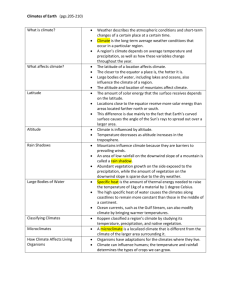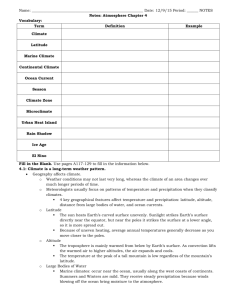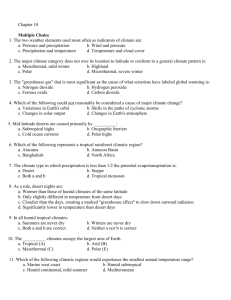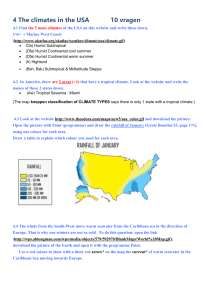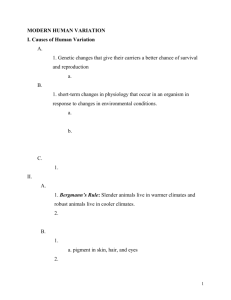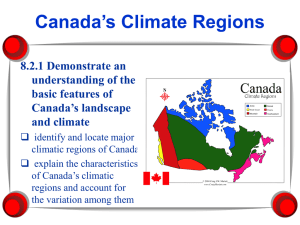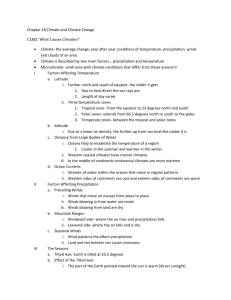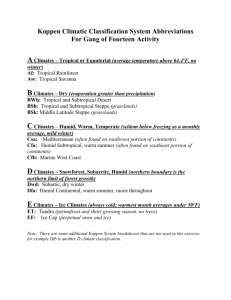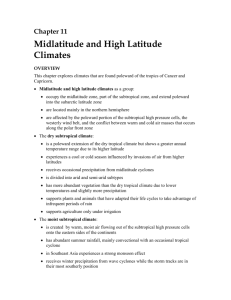On-Line Study Guide
advertisement
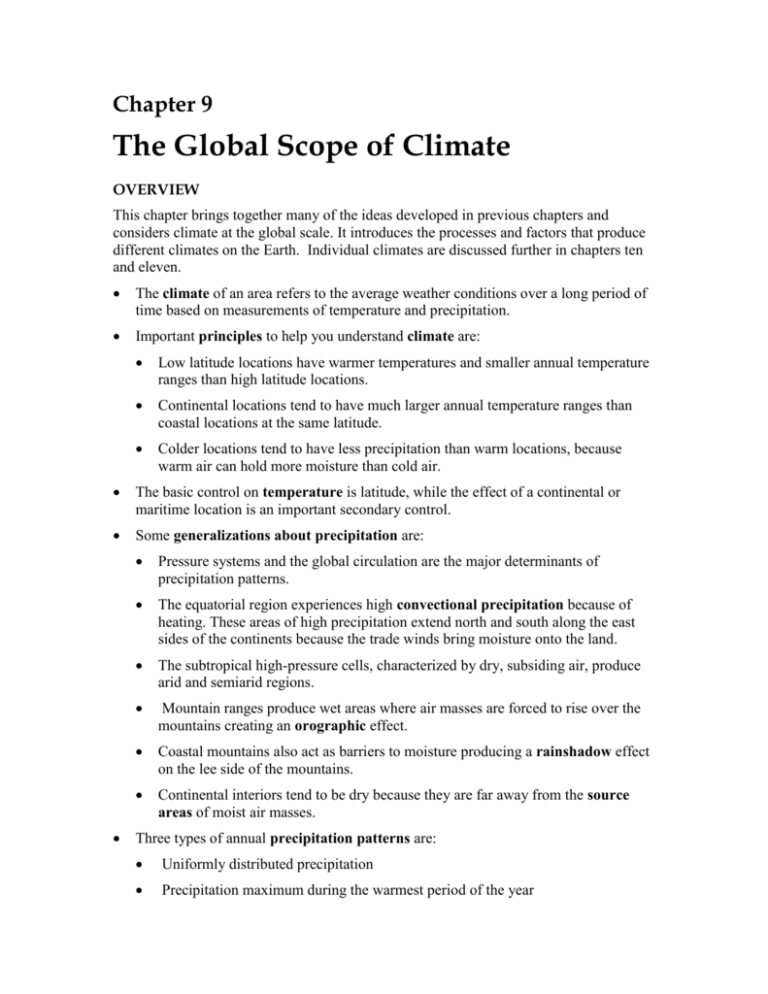
Chapter 9 The Global Scope of Climate OVERVIEW This chapter brings together many of the ideas developed in previous chapters and considers climate at the global scale. It introduces the processes and factors that produce different climates on the Earth. Individual climates are discussed further in chapters ten and eleven. The climate of an area refers to the average weather conditions over a long period of time based on measurements of temperature and precipitation. Important principles to help you understand climate are: Low latitude locations have warmer temperatures and smaller annual temperature ranges than high latitude locations. Continental locations tend to have much larger annual temperature ranges than coastal locations at the same latitude. Colder locations tend to have less precipitation than warm locations, because warm air can hold more moisture than cold air. The basic control on temperature is latitude, while the effect of a continental or maritime location is an important secondary control. Some generalizations about precipitation are: Pressure systems and the global circulation are the major determinants of precipitation patterns. The equatorial region experiences high convectional precipitation because of heating. These areas of high precipitation extend north and south along the east sides of the continents because the trade winds bring moisture onto the land. The subtropical high-pressure cells, characterized by dry, subsiding air, produce arid and semiarid regions. Mountain ranges produce wet areas where air masses are forced to rise over the mountains creating an orographic effect. Coastal mountains also act as barriers to moisture producing a rainshadow effect on the lee side of the mountains. Continental interiors tend to be dry because they are far away from the source areas of moist air masses. Three types of annual precipitation patterns are: Uniformly distributed precipitation Precipitation maximum during the warmest period of the year Precipitation maximum during the coolest period of the year Seven global precipitation regions can be identified based on these principles: Wet equatorial Trade wind coasts Tropical Deserts Midlatitude deserts and steppes Moist subtropical Midlatitude west coasts Arctic and Polar Deserts Low latitude climates are dominated by cT, mT, and mE air masses. The position of the ITC and the subtropical high pressure cell affect these climates throughout the year. Weather disturbances include the easterly wave and tropical cyclones. This group of climates includes: Wet equatorial Monsoon and trade-wind coast Wet-dry tropical Dry tropical Midlatitude climates occupy the polar front zone where warm and cold air masses conflict producing wave cyclones. This groups of climates includes: Dry subtropical Moist subtropical Mediterranean Marine west-coast Dry midlatitude Moist continental High latitude climates are dominated by polar and arctic air masses. They are sources areas of cP, mP, cA, and cAA air masses. Continental polar air meets cA air along the arctic front zone. This group of climates includes: Boreal forest Tundra Ice Sheet Dry climates are those in which the potential total annual evaporation greatly exceeds the annual precipitation amount. KEY TERMS time cycle temperature regime isohyets climate climograph Wet equatorial Monsoon and trade-wind coast Wet-dry tropical Dry tropical Dry subtropical Moist subtropical Mediterranean Marine west-coast Dry midlatitude Moist continental Boreal forest Tundra Ice Sheet climate classification steppes arid semi-arid STUDY QUESTIONS 1. 2. 3. 4. How does climate differ from weather? How do latitude and location affect temperature regimes? What factors influence precipitation patterns? List the seven precipitation regions. What are the major factors influencing precipitation patterns in each of these regions? 5. List the three seasonal precipitation patterns and explain why they occur. 6. What variables are the climate classifications in the text based on? 7. List the thirteen climates discussed in your text. Group them into low latitude, midlatitude, and high latitude climates. Summarize the main points of each climate in a sentence or two. CHAPTER QUIZ Multiple Choice Questions 1. Which of the following locations would have the largest annual temperature range? a) the Greenland Ice Sheet b) Fort Vermillion, Alberta c) Omaha, Nebraska d) Sitka, Alaska 2. What is the most important basic control on temperature patterns? a) Latitude b) Maritime or continental location c) Distance from the sun d) Air masses 3. Which of the following climates experience the lowest amount of precipitation throughout the year? a) Polar deserts b) Tropical deserts c) Midlatitude deserts d) Steppes 4. Hot, dry summers and rainy winters are associated with: a) the Mediterranean climate b) the trade wind coast climate c) the midlatitude steppe climate d) the wet-dry climate 5. The interaction of cP and cA air masses is a feature of the: a) Low latitude climates b) Midlatitude climates c) High latitude climates d) Tropical climates. True/False Questions 1. High latitude climates are most affected by activity along the polar front. (T/F) 2. A climate where the temperature remains below freezing even in summer is the ice sheet climate. (T/F) 3. A warm to hot climate with a distinct wet and dry season is the wet equatorial climate (T/F) 4. The eastern U.S. and southeastern Canada has a moist continental climate (T/F) 5. The study of climates on a worldwide basis is based on temperature and precipitation. (T/F) Short Answer Questions 1. What are the two basic controls on temperature regimes? 2. Differentiate between weather and climate. Short Essay Questions (1 - 2 paragraphs) 1. Describe the factors that produce the precipitation patterns in each of the seven precipitation regions. 2. Describe the annual temperature and precipitation cycles for the area in which you live. Discuss how these are affected by global atmospheric and oceanic circulations. Internet Resources 1. Comprehensive review of global climates and the major components of climate: <http://www.doc.mmu.ac.uk/aric/eae/Climate/climate.html> 2. Climatology and drought: <http://enso.unl.edu/ndmc/climate/climate.htm> 3. Interactive climograph of California: <http://maps.esri.com/climo/climograph.html> 4. World climate data: <http://www.worldclimate.com/index.htm> 5. The World Climate Research Program: <http://www.wmo.ch/web/wcrp/wcrphome.html>
